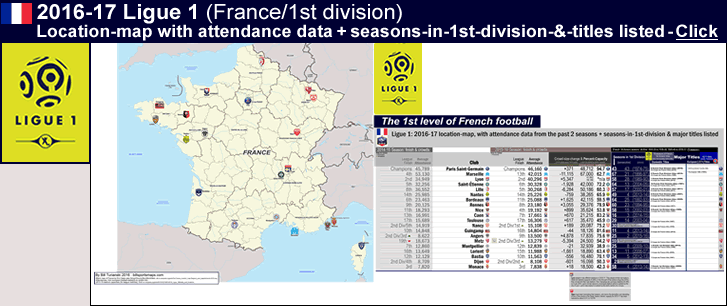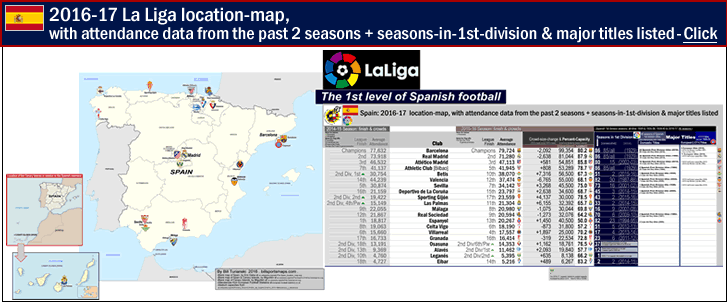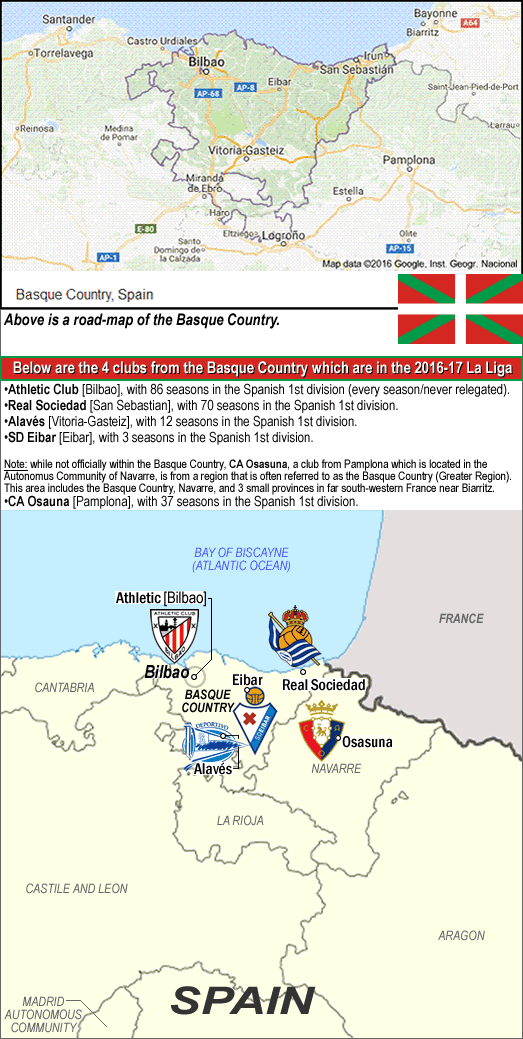
2016-17 Ligue Un [1] (France/1st division) location-map, with: 15/16 attendance data, seasons-in-1st-division-by-club & major titles listed
…
…
By Bill Turianski on 22 October 2016; twitter.com/billsportsmaps.
Links…
-Teams, etc…2016-17 Ligue 1 (en.wikipedia.org).
-Fixtures, results, table, stats…Ligue 1 [summary] (soccerway.com).
-Ligue 1 official site (in English)…ligue1.com.
New Regions of France (effective 1 Jan 2016/final decree of names on 1 Oct 2016).
…Regions in France have been reduced from 27 regions to 18 regions…Regions of France [1982-2016] (en.wikipedia.org).
…
-
The 3 promoted clubs in the 2016-17 Ligue Un (Nancy, Dijon, Metz)…
Nancy won the 2015-16 Ligue 2. Dijon finished in 2nd place in the 15/16 Ligue 2. Metz finished in 3rd place in the 15/16 Ligue 2, bouncing straight back up to Ligue 1.
-
• AS Nancy
(Est. 1967). City-population of Nancy: around 104,000/ 38th-largest city in France {see this}; metro-area population: around 434,000/ 20th-largest urban area in France {see this} {2012 estimates}. Nancy is, by road, 59 km (37 mi) S of Metz. Nancy is, by road, 160 km (99 mi) W of Strasbourg. Nancy is, by road, 385 km (239 mi) E of Paris.
Colours: Red-and White. Nicknames: ASNL, Les Chardons (The Thistles).
Manager: Pablo Correa (age 49), born in Montevideo, Uruguay. (See photo of Pablo Correa, and caption, further below.)
Major titles: 1 Coupe de France title (1978) (with Nancy winning 1-0 over Nice, the goal scored by Michel Platini in the 57th minute).
Seasons in the 1st division: counting 2016-17, Nancy have spent 30 seasons in the French 1st division. Their first season in the top flight was in 1970-71 (which was just 4 years after the club was formed, in 1967). The previous spell AS Nancy had in Ligue 1 was an eight-season spell from 2005-06 to 2012-13.
Thus far, up to 10 games (on 22 October), Nancy have had a horrible time of it back in Ligue 1, and have only won once, and sit in the relegation zone. Nancy are drawing pretty well, though, at 17.7 K per game. That is an increase of 2.6 K from last year. They are filling their stadium well, playing to 88.2 percent-capacity.

Photo and Image credits above -
Photo of 16/17 Nancy jersey unattributed at footballkitnews.com/jpg. Aerial photo of Foire de Nancy 2010 (2010 Fair of Nancy) -Cours Léopold, photo by François Bernardin at File:Foire-de-Nancy Cours-Léopold.JPG (commons.wikimedia.org). Skyline view of central Nancy, photo by Toltek at File:NancycentreEst.jpg (commons.wikimedia.org). Aerial shot of Stade Marcel Picot, photo by AS Nancy at asnl.net/stade_presentation. Shot of AS Nancy supporters with scarves held up, photo by Lolotho at File:Supporter asnl.jpg (commons.wikimedia.org). Photo of MauriFred Marvaux at gettyimages.in. Photo of Antony Robic celebrating with fans, photo unattributed at football365.fr.
Photo of coach Pablo Correa celebrating promotion (April 25 2016), photo by Jean-Christophe Verhaegen/AFP at zimbio.com. Photo of AS Nancy players and staff singing as they celebrate promotion (April 2016), photo by Jean-Christophe Verhaegen/AFP at zimbio.com. Promotion celebration in Nancy city centre, photo by Fans Of Nancy (@asnlfans) | Twitter.
…
- • Dijon
(Est. 1998). City-population of Dijon: around 152,000/ 17th-largest city in France {see this}; metro-area population: around 239,000 {2012 estimates}. Dijon is, by road, 263 km (163 mi) SE of Paris.
Colours: Red-and White-with-Black-trim. Nicknames: DFCO, Les Rouges.
Manager: Olivier Dall’Oglio (age 52), born in Alès, southern France.
Major titles: (none).
Seasons in the 1st division: counting 2016-17, Dijon have spent 2 seasons in the French 1st division. Their first season in the top flight was in 2012-13.
Dijon have been renovating their stadium, and due to the demolition and rebuilding of one of the stands at the Stade Gaston Gérard, capacity for 2016-17 has been reduced by about 5.3 K, to 10,578. Dijon began the 16/17 campaign poorly, but have recently improved their form and are unbeaten in 4 – with a win and then 2 draws, then a 1-0 win (v Lorient on 22 October), and Dijon have moved above the relegation zone. Dijon currently (Oct. 22 2016) are playing to a decent 82.9 percent-capacity after 5 home matches, at 8,846 per game at their (temporarily-reduced-capacity) stadium.
Here is a map-and-post that I made, from 2011, which features Dijon, when they had gained promotion to Ligue 1 for the first time; it has more information on Dijon’s ongoing stadium re-build…France: the 3 promoted clubs from Ligue 2 to Ligue 1, for the 2011-12 season (Évian TG, Ajaccio, Dijon).

Photo and Image credits above –
16/17 Dijon jersey, photo by Dijon FCO at dfco.fr/shop. Aerial photo of Dijon city centre, photo unattributed at kukly-bratc.ru/[Djon France] k.e. Interior-photo of stadium, photo unattributed at essma.eu e. Shot of recently-built stand, photo unattributed at stadedijonfootball.t.s.f.unblog.fr. Olivier Dall’Oglio, photo unattributed at sofoot.com. Júlio Tavares, photo by dijon-sportnews.fr. Loïs Diony, photo by Emmanuel Lelaidier at francetvsport.fr/football/ligue-2. Tavares jumping in celebration, photo by Ligue 1 at ligue1.com/ligue1/article/dijon-secure-promotion.
…
- • Metz
(Est. 1967). City-population of Metz: around 119,000/ 30th-largest city in France {see this}; metro-area population: around 389,000 {2012 estimates}. Metz is, by road, 59 km (37 mi) N of Nancy. Metz is, by road, 167 km (104 mi) NW of Strasbourg. Metz is, by road, 331 km (206 mi) E of Paris.
Colours: Garnet-Red-and-White. Nicknames: Les Grenats (the Maroons), les Messins, les Graoullys (the Dragons).
Manager: Philippe Hinschberger (age 56), born in Algrange, Lorraine (which located is 18 miles south of Metz). (For more on Philipe Hinschberger, who played his entire 15-year career with FC Metz, see photos and captions further below.) Hinschberger got Metz promoted back to Ligue 1 by the narrowest of margins, finishing in 3rd, even on points AND even on goal difference with Le Havre, but with 2 more goals scored than Le Havre.
Major titles: 2 Coupe de France titles (1984 & 1988). In the 1984 Coupe de France Final, Metz beat Monaco 2-0 (aet), with goals by (current-Metz-coach) Philippe Hinschberger in the 104th minute, and by Slovenian-German FW Tony Kurbos in the 108th minute. Four years later, Metz won the Coupe de France title again, this time in a 5-4 penalty shootout following a 1-1 score with FC Sochaux-Montbéliard. Scottish FW Eric Black had scored the Metz goal in the 45th minute, nine minutes after a Sochaux goal in the 36th minute. After the scoreless added extra time, all 5 Metz players scored their penalties (Bernard Zénier, Philippe Hinschberger, Jean-Louis Zanon, Christian Bracconi, Sylvain Kastendeuch). Metz have never won the French title, but came agonizingly close in 1997-98, when they finished even on points with RC Lens, but lost out on winning the league on a goal difference of 5 (Lens had 68 points and a goal difference of +35; while Metz had 68 points and a goal difference of +30).
Seasons in the 1st division: counting 2016-17, Metz have spent 59 seasons in the French 1st division. Their first season in the top flight was in 1935-36 (which was the fourth season of the professional French first division [ie, Ligue 1).
Metz might have barely squeaked into the 1st division last season, but seem to be holding their own in Ligue 1 in 2016-17. They started out strong, although they have lost two in a row as of 22 October, and Metz sit right at mid-table on 4 wins, one draw, and 4 losses. As of that date, Metz are drawing OK, as they have seen a 3.4 K-increase from last season (to 16.7 K)...but they are playing to just a 65.1 percent-capacity. So perhaps Metz' stadium is a bit too big (their Stade Saint-Symphorien has a 26.6-K-capacity, and was at a 2-K-reduced 24.5-K-capacity last season in Ligue 2, and is currently at a slightly-reduced 25.6-K-capacity for their Ligue 1 games this season). {From the excellent Ligue 1 official site, here are current attendances and capacities.}
Metz is the 30th-largest city in France. Metz is capital of the department of Moselle, and capital and largest city in the historical province of Lorraine. Metz is located at the confluence of the Moselle and Seille Rivers. Metz is very nearby another promoted club from Lorraine - Nancy.
Timeline of Metz, from the 12th century to the present-day...
In 1189, the city of Metz rose to the status of a Free Imperial City in the Holy Roman Empire (from 1189-1552).
In 1552, following the Siege of Metz, Metz was ceded by the Holy Roman Empire, and became part of the Kingdom of France (from 1552-1871).
In 1871, after the Franco-Prussian War, Metz was re-gained by Germanic-speaking people: Metz became part of the German Empire (from 1871-1918).
In 1919: after the First World War, and following the Treaty of Versailles, Metz became part of France again (from 1919-1940).
In 1940: during WW II, (with the Annexation of the Moselle), Metz was again re-gained by Germany [well, maybe not Germany per se, but by the Nazis] [and Metz briefly became part of the Third Reich].
On 13 Dec. 1944: the Battle of Metz ended; the Germans [Nazis] were ousted. Metz was re-gained by France for the third time.
…

Photo and Image credits above –
16/17 Metz jersey, photo unattributed at 4.bp.blogspot.com/[jpg]. Photo at twilight of confluence of the Moselle and the Seille rivers in Metz, photo unattributed at militaryingermany.com/discover-metz-france. Aerial shot of Stade Saint-Symphorien, photo by FC Metz at thinkfoot.fr/stade-football [metz]. Panoramic interior shot of Stade Saint-Symphorien, photo by Yann Dupré at elsass-groundhopping.over-blog.com/2016/05/stade-saint-symphorien-metz. Photo of Habib Diallo, photo by Michel Dell’Aiera via wort.lu/fr/sport. Photo of Christian Bekamenga, photo by Fred Marvaux at gettyimages.com. Photo of Yeni N’Bakoto by Fred Marvaux/Icon Sport via footballclubdemarseille.fr. Photo of 1982 Panini trading card of Philipe Hinschberger, photo from oldschoolpanini.com. Photo of Philipe Hinscberger at FC Metz promotion celebration (30 April 2016), photo by Le Républicain Lorrain via forum-fcmetz.com/[promotion-celebration FC Metz April 2016].
___
Thanks to all at the links below…
-Blank map of France, by Eric Gaba (aka Sting)/Otourly/NordNordWest, at File:France adm-2 location map.svg (en.wikipedia.org).
-Attendances, from E-F-S site, european-football-statistics.co.uk/attn.htm.
-2015-16 stadium capacities (for league matches), from en.wikipedia.org/wiki/2015%E2%80%9316_Ligue_1#Stadia_and_locations.
-Coupe de France titles, from en.wikipedia.org/wiki/Coupe_de_France#Performance_by_club.
-French 1st division titles, from en.wikipedia.org/wiki/Ligue_1#Performance_by_club.





